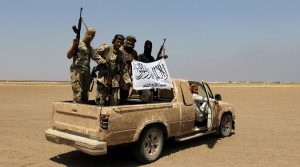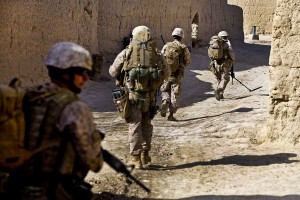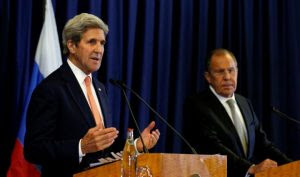
Fighters seeking the overthrow of Syrian government (Ammar Abdullah, Reuters)
Sadly, but not surprisingly, the deal reached by the U.S. and Russia on Syria last week, appears to be faltering. Russian media, quoting the Russian military, reports that the U.S. is still not following through on its promises to separate out the “moderate” opposition from Al-Nusra (which has recently changed its name). RT reported the following on September 15th:
Russia says the U.S. is not keeping its end of the bargain on the Syrian ceasefire and has continued its calls for Washington to make public all documents relating to the deal. The Russian military says Damascus is the only party observing the agreement.
“On the third day of the ceasefire only the Syrian Army is observing it. Meanwhile, the U.S.-led ‘moderate rebels’ are intensifying the shelling of residential areas,” Russian Defense Ministry spokesman Igor Konashenkov said on Thursday.
The ministry said in a press briefing that “new conflict flashpoints are appearing” and that government forces and civilians had been shot at 45 times over the past 24 hours, without firing back.
The military added that the U.S. failed to deliver on its promise to separate truce-observing moderates and truce-violating terrorists and is now “apparently trying to use a smoke-screen to cover up the violations of their part of the deal.”
The ministry called on the Pentagon to hand over up-to-date and detailed information about the location of the various factions in the conflict.
….Earlier, the U.S. said that both Damascus and the rebels were reported as violating the ceasefire, which began on Monday. Washington acknowledges its responsibility to stop violations committed by the anti-government forces.
“We’ve always been clear, just as we have said that Russia’s responsibility is to exert influence or put pressure – however you want to put it – on the regime to abide by the cessation of hostilities, it is incumbent on us to persuade, convince the moderate opposition to also abide by the cessation of hostilities, and ultimately, that’s a decision they’re going to have to make,” U.S. State Department spokesman Mark Toner said Wednesday.
“We’re continuing our outreach to the Syrian moderate opposition – that’s been ongoing – and trying to explain the arrangement to them, answer their questions. And again, we’ve seen, as I said, sporadic reports of violence, but in large part we think [the ceasefire] is holding,” he added.
Alexander Mercouris writes over at The Duran:
Various Jihadi groups are refusing to dissociate themselves from Jabhat Al-Nusra. Though there appears to have been a falling off in the fighting, some fighting is still taking place, and Russian troops on the Castello road have been caught on film coming under fire. [Russia’s TASS news agency had reported on the 13th that Russian marines had taken up positions on Castello Road – the supply route used by the rebels/terrorists from the north – which had recently been taken by the Syrian army, in an effort to implement the apparent ceasefire terms requiring Damascus to pull back and allow the set up of humanitarian corridors enabling the exit of civilians and rebels willing to lay down their arms – NB]
The Russians are complaining that the US is still not providing information on Jabhat Al-Nusra that it promised, and has failed to force the Jihadi groups it sponsors to dissociate themselves from Jabhat Al-Nusra and to observe the ceasefire.
Meanwhile the air is thick with arguments about the provision of humanitarian aid to Jihadi controlled eastern Aleppo. Jihadi groups are blocking the aid the UN is providing, complaining that it is not what they want, and because they say they reject the US – Russian agreement under which it is being provided, whilst the UN – entirely predictably – is blaming the Syrian government. Needless to say there is no sign of any withdrawal of Jihadi fighters from eastern Aleppo by way of the Castello road.
In the midst of all these charges and counter charges the Russians are calling for the text of the agreement with the US to be published whilst the US is saying no – a fact which incidentally all but confirms that it was the US that made the major concessions in order to reach the agreement.
Not only is Russia now requesting that the terms of the Syria deal be made public so as to subject it to better accountability, but Moscow is also moving to have it officially backed by a UN Security Council resolution, according to Reuters:
UNITED NATIONS- Russia is pushing for the United Nations Security Council to adopt a draft resolution next week endorsing a Syria ceasefire deal agreed by Moscow and Washington, Russia’s U.N. Ambassador Vitaly Churkin said on Thursday.
The deal reached on Saturday, September 10 aims to put Syria’s peace process back on track. It includes a nationwide truce that started at sundown on Monday, improved humanitarian aid access and joint military targeting of banned Islamist groups.
Russian Foreign Minister Sergei Lavrov and U.S. Secretary of State John Kerry agreed on five documents, which they said would not be publicly released. However, on Thursday, France called on Washington to share details of the deal.
Churkin said Russia was working on a draft Security Council resolution that would endorse the deal. When asked if the deal would need to be annexed to such a resolution, he said: “We don’t know yet.”
“We’re working on it … I think we need to adopt it on the 21st (of September), this would make sense,” Churkin told reporters.
The 15-member Security Council is due to hold a high-level meeting on Syria next Wednesday during the annual gathering of world leaders at the United Nations. Kerry and Lavrov are expected to attend, diplomats said.
Note that France has now joined in the call for the terms of the deal to be made public. On that note, some more details have come out about the deal, including some of the concessions made by each side and what steps Washington has made to attempt to separate the “moderates” from Al-Nusra (whatever name the Al Qaeda backed organization is going by nowadays). Gareth Porter, an independent journalist and expert on the Middle East, who has done some excellent reporting on both Syria and Iran over the past few years, has reported the following:
The new bargain is actually a variant of a provision in the Feb. 27 ceasefire agreement: in return for Russian and Syrian restraints on bombing operations, the United States would prevail on its clients to separate themselves from their erstwhile Al Qaeda allies.
But that never happened. Instead the U.S.-supported groups not only declared publicly that they would not honor a “partial ceasefire” that excluded areas controlled by Al Qaeda’s affiliate, then known as Nusra Front, but joined with Nusra Front and its close ally, Ahrar al Sham, in a major open violation of the ceasefire by seizing strategic terrain south of Aleppo in early April.
….As the Kerry-Lavrov negotiations on a ceasefire continued, Kerry’s State Department hinted that the U.S. was linking its willingness to pressure its Syrian military clients to separate themselves from Al Qaeda’s forces in the northwest to an unspecified Russian concession on the ceasefire that was still being negotiated.
It is now clear that what Kerry was pushing for was what the Obama administration characterized as the “grounding” of the Syrian air force in the current agreement.
Now that it has gotten that concession from the Russians, the crucial question is what the Obama administration intends to do about the ties between its own military clients and Al Qaeda in Aleppo and elsewhere in the northwest.
Thus far the primary evidence available for answering that question is two letters from U.S. envoy to the Syrian opposition Michael Ratney to opposition groups backed by the United States. The first letter, sent on Sept. 3, after most of the Kerry-Lavrov agreement had already been hammered out, appears to have been aimed primarily at reassuring those Syrian armed groups.
As translated by al-Monitor, it asserted, “Russia will prevent regime planes from flying, and this means there will not be bombing by the regime of areas controlled by the opposition, regardless of who is present in the area, including areas in which Jabhat Fateh al Sham [the new name adopted by Al Qaeda’s Nusra Front] has a presence alongside other opposition factions.”
Ratney confirmed that the U.S. would in return “offer Russia coordination from our side to weaken al Qaeda.” But he also assured U.S. clients that their interests would be protected under the new agreement.
“[W]e believe this ceasefire should be stronger,” he wrote, “because it should prevent Russia and the regime from bombing the opposition and civilians under the pretext that its striking Jabhat al Nusra.”
The Ratney letter makes no reference to any requirement for the armed opposition to move away from their Al Qaeda allies or even terminate their military relationships, and thus implied that they need not do so.
But in a follow-up letter, undated but apparently sent on Sept. 10, following the completion of the new Kerry-Lavrov agreement, Ratney wrote, “We urge the rebels to distance themselves and cut all ties with Fateh of Sham, formerly Nusra Front, or there will be severe consequences.”
The difference between the two messages is obviously dramatic. That suggests that one of the last concessions made by Kerry in the Sept. 9 meeting with Lavrov may have been that a message would be sent to U.S. military clients with precisely such language.
The totality of the two letters from Ratney underlines the reluctance of the United States to present an ultimatum to its Syrian clients, no matter how clearly they are implicated in Al Qaeda operations against the ceasefire. Last spring, the State Department never publicly commented on the participation by the U.S.-supported armed groups in the Nusra Front offensive in violation of the ceasefire agreement, effectively providing political cover for it.
***********

(Ousted Libyan leader Muammar Gaddafi shortly before he was murdered on Oct. 20, 2011.)
Robert Parry at Consortium News has written another critical piece, this time discussing a little-talked about report undertaken by Britain’s Foreign Affairs Committee, which exposes the lies and exaggerations about Qaddafi’s actions used to justify NATO’s regime change in Libya in 2011:
The report from the U.K.’s Foreign Affairs Committee confirms that the U.S. and other Western governments exaggerated the human rights threat posed by Libyan leader Muammar Gaddafi and then quickly morphed the “humanitarian” mission into a military invasion that overthrew and killed Gaddafi, leaving behind political and social chaos.
The report’s significance is that it shows how little was learned from the Iraq War fiasco in which George W. Bush’s administration hyped and falsified intelligence to justify invading Iraq and killing its leader, Saddam Hussein. In both cases, U.K. leaders tagged along and the West’s mainstream news media mostly served as unprofessional propaganda conduits, not as diligent watchdogs for the public.
….According to the new U.K. report on Libya, Britain’s military intervention – alongside the U.S. and France – was based on “erroneous assumptions and an incomplete understanding” of the reality inside Libya, which included a lack of appreciation about the role of Islamic extremists in spearheading the opposition to Gaddafi.
In other words, Gaddafi was telling the truth when he accused the rebels around Benghazi of being penetrated by Islamic terrorists. The West, including the U.S. news media, took Gaddafi’s vow to wipe out this element and distorted it into a claim that he intended to slaughter the region’s civilians, thus stampeding the United Nations Security Council into approving an operation to protect them.
That mandate was then twisted into an excuse to decimate Libya’s army and clear the way for anti-Gaddafi rebels to seize the capital of Tripoli and eventually hunt down, torture and murder Gaddafi.
Yet, there was evidence before this “regime change” occurred regarding the extremist nature of the anti-Gaddafi rebels as well as those seeking to overthrow Bashar al-Assad in Syria. As analysts Joseph Felter and Brian Fishman wrote in a pre-Libya-war report for West Point’s Combating Terrorism Center, “the Syrian and Libyan governments share the United States’ concerns about violent salafist/jihadi ideology and the violence perpetrated by its adherents.”
In the report entitled “Al-Qaeda’s Foreign Fighters in Iraq,” Felter and Fishman also analyzed Al Qaeda’s documents captured in 2007 showing personnel records of militants who flocked to Iraq for the war. The documents revealed that eastern Libya (the base of the anti-Gaddafi rebellion) was a hotbed for suicide bombers traveling to Iraq to kill American troops.
….This reality was known by U.S. officials prior to the West’s military intervention in Libya in 2011, yet opportunistic politicians, including Secretary of State Clinton, saw Libya as a stage to play out their desires to create muscular foreign policy legacies or achieve other aims.
Some of Clinton’s now-public emails show that France’s President Nicolas Sarkozy appeared to be more interested in protecting France’s financial dominance of its former African colonies as well as getting a bigger stake in Libya’s oil wealth than in the well-being of the Libyan people.
An April 2, 2011 email from Clinton’s personal adviser Sidney Blumenthal explained that Gaddafi had plans to use his stockpile of gold “to establish a pan-African currency” and thus “to provide the Francophone African Countries with an alternative to the French franc.”
Blumenthal added, “French intelligence officers discovered this plan shortly after the current rebellion began, and this was one of the factors that influenced President Nicolas Sarkozy’s decision to commit France to the attack on Libya.” Another key factor, according to the email, was Sarkozy’s “desire to gain a greater share of Libya oil production.”
For Clinton, a prime motive for pushing the Libyan “regime change” was to demonstrate her mastery of what she and her advisers called “smart power,” i.e., the use of U.S. aerial bombing and other coercive means, such as economic and legal sanctions, to impose U.S. dictates on other nations.
Parry goes on to explain how Washington policymakers have apparently learned nothing from the chaos and humanitarian disasters they have created with their regime change operations, continuing with a reckless propaganda campaign against Russian President Vladimir Putin – part of the pattern in the run-ups to regime change operations against foreign governments that do not bow to Washington’s dictates. The fact that Russia represents the world’s other nuclear super-power is not serving as a deterrent in this regard.
For more on the lies and propaganda peddled by the western corporate media and certain mainstream human rights organizations, which enabled the war against Libya, please see the Harvard Belfer Center’s report, Lessons from Libya: How Not to Intervene.
http://belfercenter.ksg.harvard.edu/publication/23387/lessons_from_libya.html
Finally, military analyst and blogger, Moon of Alabama, has exposed the New York Times‘ pathetic lack of knowledge on a war and country they are tasked with informing Americans about when they wrote a piece attempting to mock Libertarian presidential candidate, Gary Johnson’s ignorance when asked about the siege of Aleppo in Syria (Johnson answered “What is Aleppo?”). It took several corrections of the original piece before the Times gave an accurate characterization of the city of Aleppo.
Read it here.
It never fails to amaze me how intelligent people I talk to still give the NYT credibility and think they are well-informed if they read this outlet which has allowed itself to become a rag.
Like this:
Like Loading...









